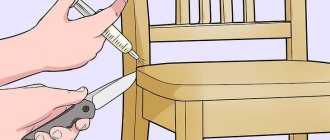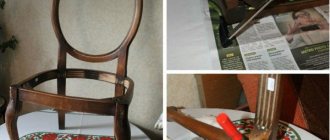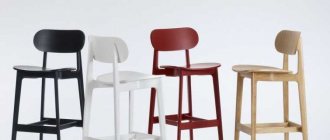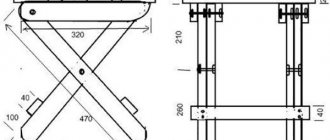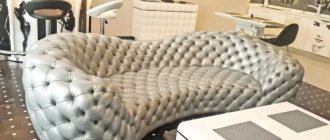My home is always open for you! This is my dining room. All the furniture in it is oak. This is a chair - they sit on it. This is the table - they eat at it.
Marshak Samuil Yakovlevich “Cat House”
Everyone remembers these words and the fairy tale itself from their happy childhood. This is a small piece of the play “Cat's House”, the first version of which was written back in 1922. Surely no one asks the question of what a chair is, how and when it appeared. It has become so familiar and commonplace. Therefore, let's look at the chair from a historical point of view.
What is a chair?
A chair is a piece of furniture, with a seat and a back, designed to sit one person.
The history of the origin of the stool. When and how did it appear in Russia? Detailed history of the stool and its structure.
The chair is a middle option between a stool and an armchair. The difference is that the stool has only a seat and does not have a back and armrests. And an armchair, unlike a chair, has, in addition to a back, also armrests and arms on the sides, on which you rest your elbows.
Chairs are the most common type of seating furniture today. There are a great many types and models of chairs, but we will try to classify chairs a little later.
Additional classification of chairs:
- by appointment;
- by design;
- by style.
A chair is furniture that, more than any other type, has been influenced by fashion and the development of progress.
Do you need construction services?
The time has come to start talking about specific pieces of furniture that did not appear yesterday, but which in the current 21st century decorate the interior of both city apartments and country houses. In this conversation, we also cannot escape the story of the “past life” of objects, for each of them has its own unique history, which sometimes goes back many centuries.
Today we are starting a conversation about a chair - a piece of furniture that no homeowner can do without. Starting our acquaintance, according to tradition, we will turn to Wikipedia, from which we learn that “a chair (considered an Old Russian word borrowed from Germanic languages...) is a piece of furniture intended for sitting one person and having legs and a back. Similar furniture without a back is called a stool (we have a conversation about the stool ahead - approx. A.K.). The main parts of a chair are the seat and the back; in a typical chair, the seat rests on four legs; sometimes the design of the chair includes armrests. A luxury chair with armrests can be called an armchair (we will talk about the armchair in detail a little later - approx. A.K.)…
Chairs, as a rule, are not attached to the floor with their legs, and therefore they can be moved around the room.
There is usually a gap between the seat and the back of the chair left for ventilation. For the same purpose, the back and seat are sometimes made of porous material or have holes, which is also a decorative element.”
It would seem that a chair should have been a “faithful friend” of any person at all times. Actually this is not true. Since ancient times, not everyone could sit on it. Or rather, not everyone was allowed to sit on this piece of furniture. True, today it is difficult to say who exactly was allowed to sit on a chair in the Stone Age. In Ancient Greece, this privilege was given to women and children. In Ancient Rome, only people belonging to the wealthy class could use this piece of furniture. In subsequent centuries, it continued to remain not just a piece of furniture, but also an indicator of the importance of its owner. Moreover, minimal attention was paid to convenience. The main thing was that the chair would impress others with its splendor. Each owner of this piece of furniture spared no expense in its creation, and materials such as marble, silver, and sometimes gold were widely used in its production. The fact that a chair should not only be an object of admiration and decoration of a room was “attention” in Europe at the end of the 16th and beginning of the 17th centuries. It was then that fundamentally new chairs , called “chaise lounge”. They were intended mainly for afternoon relaxation. In fact, the chaise lounge combined a chair, an armchair, and a bed. A century has passed since the appearance of sun loungers, and only then did they begin to win hearts. If the first sun loungers were made of wood and upholstered with fabric, then with the development of their production, in addition to wood, craftsmen began to use metal. “Improved” sun loungers were upholstered not only in fabric, but also in leather. Along with sun loungers, “modernized” chairs began to be used in Europe. The expression “sitting on money” appeared when European craftsmen proposed a new model for that time - a chest with a back. A privileged European hid his money in such a chest and literally sat on it. At the same time, rocking chairs began to appear (we will talk about them in detail in conversations dedicated to chairs).
But if Europeans began to treat both chairs and chaise lounges differently, then in Russia benches were still the main piece of furniture on which to sit. Only royalty could afford to have a chair. Moreover, he was the subject of ceremonies and was brought into the hall after the king. At its core, this piece of furniture was a throne. It was, as they would say today, exclusive. The appearance of the throne left no one indifferent who could see it. But the kings were unlikely to experience any particular comfort from sitting on the throne, since the seat was quite hard and the back was straight.
If in the 17th century in Europe furniture makers continued to pay attention to the design of a chair and a chaise longue (so that the owner of such furniture could sit comfortably on it), then in Russia they did not pay attention to such “trifles”. And mere mortals could not use these pieces of furniture. In the 18th century, these housing elements appeared not only among wealthy Russian people, but in the 19th century they became the property of the owners of village houses and estates. They clearly did not look like a throne, but compared to the shops, they had a respectable appearance. Humanity owes the appearance in Russia, and not only in Russia, of chairs in large quantities to the Viennese master Mikhail Thonet. The mere fact that history has preserved the name of this carpenter speaks of the significance of his contribution to furniture craftsmanship. To produce this furniture, Thonet proposed using bent wood (later such furniture became known as “Viennese furniture”). Realizing the superiority of these elements of chairs, craftsmen in other countries, including Russia, began to use another bendable material as the main parts. This is how products made from bent pipes, bent metal fragments, and also from bent plywood appeared (in our days, this list has been supplemented by products made from bent glass and plastic).
In Rus', wood was used for a long time, and our craftsmen brought something of their own into furniture production that was not inherent in foreign chairs. In addition to the fact that Russian products were painted in different colors, folk craftsmen began to use wood carving in their production. By the 20th century, a chair was no longer an indicator of wealth and, along with beds, sideboards, chests, cabinets and tables, took its place both in the homes of wealthy people and in the homes of more modest-income residents of our country.
Next time we will talk about chairs of the Soviet period, after which we will move on to a conversation about wicker models of these home elements.
Alexey Kaverau
The article uses photographs of the sites: vinotti, mebel-lamuza, gazeta.sebastopol, history-life, kommari.livejournal, gorod.cn, tass-ural
Etymology of the word "CHAIR"
The exact etymology of the word is unknown, but it is believed that the word is an Old Russian loanword. If we compare the spelling, we see the following:
- Old Icelandic – Stóll;
- German – Stuhl;
- Crimean-Gothic – stul.
The spelling and pronunciation are almost the same, so it is generally accepted that the word came from the Germanic languages.
The specialist carpenter who made chairs was called a “chairmaker” or “chairmaker.”
Office chair - characteristics
This type of furniture is radically different from a simple stool or lounge chair. Products intended for long-term office work in an almost unchanged position at the table must optimally suit the person in terms of height and other anthropological data. When choosing a chair for an office or study, it is advisable to compare the characteristics of the samples you like. A photograph or a quick inspection of the appearance of a display case does not provide complete information; when studying the passport, familiarize yourself with the following parameters:
- Upholstery and frame material.
- The presence of adjustment mechanisms (height and depth of the backrest, tilt angles).
- Dimensions of the assembled product.
- If you purchase a folding office chair, then you need to know its dimensions, taking into account all the adjustments.
- Color and design.
- The weight of the product itself.
- Maximum weight load on the seat.
- Cost.
- Manufacturer.
History of the chair
So we get to the history of the appearance of chairs.
In the historical annals there is no exact indication of the date and place of birth of the chair. But, judging by historical references, we can assume that the ancient Egyptians invented chairs. According to drawings and finds during excavations, the found fragments and entire pieces of furniture, including chairs, are attributed to the Third Dynasty of Ancient Egypt, which is the 3rd millennium BC. Finds from those times looked massive, usually cubic in shape. Only later, at the beginning of the “friendship” of the Egyptian peoples with the peoples of Middle Asia and under the influence of fashion, culture and tastes of those places and times, the chair begins to change shape. The design becomes more sophisticated, the legs are curved or curly. Cushions appear on the seats and backs for comfort. A little later, people invented folding chairs, which used a piece of leather as a seat, and metal stools were used in military campaigns.
The drawings of the Second Dynasty of Ancient Egypt show simple chairs, the legs and backs of which are straight, with a cushion on the seat. In everyday life, chairs with cross-shaped legs are widely used. But in Assyria, the shapes of chairs become more intricate. The silhouette of the chair itself is rounded or curved. The legs often look like animal paws.
Chairs for the nobility and royalty, throne chairs were decorated with carvings, precious metals and stones, and covered with exquisite carpets.
People are eating less and less while lying on carpets. The habit of eating food at tables, sitting on chairs, has become commonplace.
Chairs come from neighbors and to Greece. In Ancient Greece there were no special requirements for the type and materials of chairs; all types and shapes of chairs from Egypt and Assyria were used here at the same time.
Ancient Rome made some changes to the structure of chairs. In theaters, the lack of benches is compensated for by light folding chairs. And the chairs themselves are starting to be made with armrests or even without a back, but with armrests. Various shapes of chair seats are used: square, rectangular, round, oval and triangular. They began to make furniture, in particular, chairs from willow twigs and wicker.
Europe could not do without comfortable furniture and also borrowed such an item as a chair. The form of mass furniture was absolutely identical to the Roman one, but for kings and persons of high rank, not only the chairs, but also the rest of the furniture copied the style of India. Such furniture was luxuriously decorated with stones, metals and elaborate carvings. The seats were often not round, but polygonal, five or hexagonal. The back of such a chair could cover almost all edges. The space between the legs of such a rich chair was covered with a sculpture or tile carved from wood depicting an animal or the coat of arms of the family.
In the 15th century, engineering invented chairs with a swivel seat and chairs with wheels at the ends of the legs for rolling chairs. And in the 16th century, they began to make cheap furniture for common people; reeds were used in chairs to soften the seat and back. The chair in Europe is becoming the main furniture for sitting, displacing stools, benches and chests in the form of low boxes for storing things and sitting at the same time.
In Europe of the Middle Ages, chairs for special occasions were complemented by a canopy, for example, the cross-shaped chair with a canopy common in Italy is known today as the Savonarola chair.
In Holland in the 17th century, chairs with cross-shaped legs for everyday use came into fashion and were widely made. And in England, Germany and France, such chairs were intended for ceremonies. A little later, in England, the aristocracy began to use upholstered chairs, the Farthingale style. Such a chair had a gap between the seat and the back, thanks to which ladies wearing dresses with whalebone cuffs could sit comfortably on it. The largest chair belonged to the head of the family. Only commoners continued to sit on wooden chairs.
The 18th century comes and Windsor style chairs come into use in England. Windsor chairs are a rustic style of furniture, with simple legs and backs and thin rods.
Michael Thonet, a furniture maker from Vienna, around the middle of the 19th century, invents an industrial, non-manual method, technology for bending wood under steam. Before this, the technology was manual, which required a certain skill and time. The cheaper and faster production of bent wood led to the fact that the previously expensive Windsor chair became relatively cheap. The "Windsor chair", a chair made of bent wood, was considered country furniture in 18th-century England. And as a result of large-scale production, now the “Viennese Chair,” as Thonet’s products were called, captivated Europe. The Viennese chair was also called a bistro chair. By 1930, more than 50,000,000 of these chairs were produced and sold in Europe.
The order of work taking into account the type of model
When the drawings with dimensions are completely ready, you can start cutting out the parts. Place a pattern on the beams or boards, trace the contours with a pencil, then cut out the workpiece. Experts recommend treating wood with antiseptics to protect it from water, fungi and other negative factors.
With soft seat
To create a chair from solid wood, you will need 15 mm boards, timber with a section of 40 x 40 mm, a piece of plywood 45 x 45 cm, foam rubber for a soft seat 45 x 45 cm, upholstery fabric 55 x 55 cm. The work is carried out in stages:
- The tree is cut to produce a pair of legs, transverse slats, 4 drawers. A seat is cut out of plywood.
- Markings are applied to connect the back, drawer, and legs in accordance with the drawing.
- Make the necessary holes and clean them with a chisel. On the slats and prongs, mark the dimensions for the tenons and carefully cut them out.
- The edges of the backrest, necessary for joining, are treated with glue and inserted into the grooves of the rear legs of the chair. The element is secured with clamps.
- The front drawer is glued to the legs and dried.
- The frame is assembled without the use of glue; if there are no defects, the product is glued and finished assembled.
- To create soft seats, plywood is used, foam rubber is glued to it with an allowance of 1.5 cm around the entire perimeter. Upholstery fabric is fixed on top.
- After the parts have completely dried, the legs are screwed on, the slats are secured, and the seat is mounted.
- The caps of the tenons are cut off and the holes left from the screws are filled with putty. The surface of the entire chair is carefully polished.
Shapes, materials and designs of stool covers, methods of attaching them
Chairs with an upholstered seat are often produced without a back. To do this, you can use the presented description, having previously removed this element from the drawing. The result is a stool that is convenient to use in the kitchen.
Cut wood
Make holes
Fasten elements
Glue the front part
Assemble the frame
Glue connections
Assemble the structure
Make a soft seat
Secure the seat
Folding
Simple chairs are suitable for use at home and outside the city. To create a folding model, you will need short and long legs, crossbars, wooden slats for the backrest, and a seat. The work process is carried out according to the instructions:
- The bars that are used to support the seat are drilled to install a metal rod.
- The slats are fixed to the bars using self-tapping screws.
- At the upper end of the blanks for long legs, holes are drilled with an indentation of 110 mm, and cuts are made in them for the backrest. When performing, use a drawing of a chair.
- A metal rod is installed in a specially designated hole, the edges are secured in the grooves of the legs.
- In the center of the block of small legs, holes are drilled to connect with the long ones. The crossbars are fixed slightly above and below the middle.
- The manufacture of the structure is completed by assembling all the elements, which are fixed with screws.
A beautiful chair needs finishing and decoration. Today, decoupage techniques, carved elements, leggings, and various capes are increasingly used to decorate wooden furniture.
Before making a chair, you need to determine the appropriate dimensions. Only in this case the furniture will turn out to be truly useful and practical. Thanks to the wide variety of designs and finishing options, you can create exclusive things with your own hands.
Chair in Russia
In Russia, until the end of the 17th century, traditional seating furniture was used, these were chests, benches and stools. Chairs and armchairs are very scarce and are present in small quantities in very rich noble families and in royal reception chambers. Peter I begins to introduce the European way of life, and the chair becomes a common piece of furniture. It was under Peter I that a chair became an ordinary part of everyday life and interior design, and not an honorary piece of furniture that was purchased to emphasize one’s status.
In Russia in the mid-18th century there was a shortage of furniture. In simple houses, the majority continue to use benches and stools. In more prosperous families, chairs from the times of the “Petrine Baroque” also appear. These are heavy oak chairs with high backs.
At the beginning of the 19th century, fashion changed in Russia, a move away from classicism began, and it became important how the chair looked not only from the front, but also from the side. Vasily Petrovich Stasov (07/24/1769-09/05/1848), Russian architect, one of the founders of the Russian Empire style, academician of the Imperial Academy of Arts, invents a new design of chairs and armchairs with a curved profile, a side frame, a rear leg with a backrest and a front leg forming a single frame. And the right and left side frames are fastened with transverse slats. The back was fastened with a transverse plane and covered with veneer. There was a feeling that a single piece of wood was used. The seat in such chairs and armchairs was trapezoidal and embedded in the structure. Chairs of this design were comfortable, very durable, had an elegant silhouette and were at the same time easy to manufacture. Chairs designed by Stasov became the favorite furniture and the only form in merchant and noble houses for thirty years.
In the 19th century, the urban population of Russia increased significantly and continued to grow. At the same time, the demand for furniture and chairs in particular is rising. Factory production of furniture is spreading and developing and specialized furniture stores are opening, that is, if previously you turned to a craftsman and agreed on the quantity and type of furniture, now you could go into the store and buy a ready-made set of furniture, a missing item or a necessary part. For the first time, chintz is used for upholstery of chairs.
Having become saturated with European styles, furniture with elements of Russian style came into fashion in Russia in the last third of the 19th century. These are all the same shapes and models, for example, for a home dining room, heavy oak rectangular chairs were purchased, but with the addition of brocade or leather upholstery and carved wooden elements decorated with Russian folk patterns, this is how the popular style of furniture “à la russe” appeared.
At the end of the 19th century, furniture in fashion was more familiar to our eyes, according to historical films and museums, this is the furniture of Heinrich Daniel Gumbs (1765-1831). A furniture maker from the town of Neuwied in Prussia and who worked in St. Petersburg. Heinrich Gumbs is the founder of a large family of furniture makers, whose products in Russia received the general name of Gumbs furniture. The chairs made by Gumbs were very comfortable, with soft quilted upholstery on the seat and back.
Let’s finish the history of the chair here and consider what types of chairs there are and why they were invented.
Where to begin
First of all, you should decide on the material and design of the chair. There are many types of chairs with a back - a high bar stool, a high chair for feeding a child, a transformer that turns from a chair into a stepladder. In the past, it was common practice to divide chairs into living and dining chairs. The latter were distinguished by a higher back height and low position of the legs. Today, dining chairs have practically gone out of use, but if you wish, you can make such a model yourself.
Having thought through the design of the chair, you need to draw a sketch and draw drawings; you can take as a basis one of the diagrams available in books, magazines, and the Internet. Based on the drawings with dimensions, details are drawn up, the required amount of material is calculated (it must be purchased with a reserve). Then the parts are prepared, the chair is assembled and finished.
If a complex design with shaped elements is chosen, it is advisable to make drawings not only of the chair as a whole in different projections, but also of individual parts. It’s even better to draw life-size patterns, according to which parts of the required configuration will be cut out of timber, boards, plywood, and furniture panels. When drawing up drawings, they often do not indicate the names of the parts, but simply number them, and these numbers are then used in the assembly instructions. The detailing indicates the dimensions of each element and the number of identical or symmetrical parts.
But for the convenience of describing the work process, it is better to study the names of the main parts:
- drawers are the parts that form the supporting frame for the seat;
- the seat can be soft or hard;
- legs - vertical supports of the chair, the back and front usually differ in configuration, the front ones are strictly perpendicular to the ground, the rear ones slightly deviate from the vertical axis;
- in chairs with a back, the back legs, as a rule, form a single unit with its side supports. The abutments are the part that is located above the seat; the backrest is attached to them.
- the backrest connects the side supports and serves as a support for the back of a sitting person. It can be solid, made of plywood, wide boards, or inlaid, made of several slats, beams, flat or curved. Sometimes the side abutments are connected at the top by a crossbar, and between this crossbar and the rear drawer, several vertical slats are attached to form the backrest. Also the back can be soft;
- legs - parts that connect the legs of a chair and give rigidity to the structure. All legs can be located at the same height; it is also possible to have side and transverse or rear and front legs at different levels;
- crackers, jibs - these are additional elements that are installed in the corners of the drawer, give it rigidity, and also serve as support for a soft seat if it is recessed into the frame. Instead of jibs, stop strips can be used; they are attached to the side frames from the inside;
- armrests are more typical for armchairs, but they are also sometimes found in chairs.
When making an upholstered chair, it is better to place the seat not on top of the frame, but insert it into it. This reduces the load on the frame. The jibs are attached to the side frames with an indentation from their upper edge equal to the thickness of the seat frame (without taking into account the thickness of the soft cushion). It is recommended to lower the front drawer to the same height; the front jibs will be positioned flush with its upper edge. The seat is made in such a size that it slightly protrudes beyond the edge of the front drawer.
Chair design
Each chair consists of a seat, legs and back. The back of a chair can be called a shield or a leaner.
Auxiliary parts of the chair are:
- drawers - upper transverse slats that fasten the legs under the seat and can serve as a fastening for the seat;
- legs - the lower transverse slats that fasten the legs of the chair;
- bosses – corner fastenings between the legs;
- backrest - part of the chair on which the back rests;
- cap - if the chair has an upper backrest bar and a lower one, a shield with upholstery covering this space.
Usually a chair has four legs, but there are designs with cross-shaped legs in the shape of the letter “X” or panel ones, for example, a cantilever chair, where the front and back legs are not separated, but are a single piece of wood or plywood.
Chair legs, drawers and legs are the frame of the chair.
The back of the chair can be a continuation of the rear legs or be a separate structural element. The back of the chair can be solid, through or made of slats.
The main parameters when choosing a chair are:
- chair back height;
- chair height by seat;
- chair width;
- chair depth.
The height of the chair over the seat is required to determine comfort in relation to the height of the table.
Also, chairs vary in hardness and are divided into hard, semi-hard, semi-soft and soft.
The back of the chair can be the same in rigidity as the seat, or more rigid or softer.
By style, chairs are determined by size, width and depth, height of the back and seat, shape of the back and seat, upholstery, its quality and material or lack of upholstery, and the shape and type of legs.
Also, chairs are distinguished by the material from which they are made and the manufacturing method:
- carpentry - if the parts for the chair are cut from a whole solid wood, hardwood or softwood;
- bent - in the case of steam processing of wood and bending of workpieces;
- wicker - if there are parts or the entire base is woven from willow, reed, straw, vines or rattan;
- metal – if the frame is made of metal;
- combined - when using several types of material.
The Russian classifier adds a few more divisions:
- glued and bent-glued - used to reduce the cost of production and the products themselves; in production, not solid bent wood is used, but bent veneer;
- flat-laminated – plywood is used:
- stick - a type of wicker, but when weaving, sticks are used, not necessarily of the same material;
- molding - in the manufacture of casting from metal, polymers or glass;
- combined ones are divided by purpose - children's, piano, bar, etc.
The material from which the chairs are made and their design features influence the scope of use of the chairs; for example, wicker chairs are often used as country furniture. And chairs made of plastic, due to their lightness and often the ability to place one chair on top of another, as if strung together, saving space, are used for public events and summer street cafes.
Material selection
Most often, chairs are made by hand from wood. This material is environmentally friendly and can be easily processed. When choosing a suitable option, you should pay attention to the breed:
- Solid varieties. This category includes oak, maple, beech, birch, cherry, and walnut. Pros: characterized by increased strength, resistance to deformation, durability. Cons: high cost, the material is more difficult to process due to its dense structure.
- Soft breeds. This group includes alder, pine, aspen, linden, spruce. Pros: they have a straight-layer loose structure, so the material is convenient to saw, cut, glue, and the finished products are lightweight and attractive in appearance. Cons: less practical compared to hard rocks, more susceptible to mechanical damage.
There is another group of wood varieties - especially durable ones. It includes boxwood, acacia, yew, the processing of which will require special equipment.
Wooden chairs are usually made from boards 10–15 mm thick or timber with a section of 60 x 40 mm or 40 x 40 mm. Logs are used less frequently, but they must first be cut using a circular saw or grinder. An array is also suitable for work, but it is expensive, so beginners are not recommended to use this material.
When choosing suitable lumber, you need to carefully check its quality. First, pay attention to several important signs:
- boards, beams are smooth, without distortions, bends, knots;
- no chips or cracks;
- the material must be dry, without wormholes or fungi.
Varieties of chairs for bathing babies in the bathroom, manufacturers
It is recommended to make chairs with your own hands only from high-quality materials. Violation of drying rules can be visually determined. This is noticeable by cracks, warping of the surface, various irregularities, and protruding resin. Lumber that has been stored in a damp place for a long time is not suitable for furniture production.
Boards without distortions, bends, knots
No chips or cracks
Dry material, no wormholes, fungi
What other types of chairs are there and how are they divided?
By purpose
- Work chair, office chair, computer chair – these chairs are designed for long hours of work. As a rule, the design of such chairs is carefully worked out not only by designers, but also by orthopedists. These chairs are equipped with wheels for convenient movement at the desk and mechanisms for adjusting the seat height and back angle.
- A piano stool is a heavy chair with a cast base and a swivel seat without a backrest.
- Children's chair - there are many varieties of materials, but the main feature is the height of the chair. Each children's chair must indicate the approximate age of the child and the height for which the chair is intended.
- The bar stool appeared at the border of the 18th-19th centuries at the time of the arrival of a huge number of migrants to the “New World”. It is not known exactly, but it is believed that it was invented in the United States during the massive heyday of saloons. A bar stool is about 80 centimeters high, often without or with a low back, usually with a round seat. Be sure to have a shelf for your feet. The number of legs is 1, 3 and 4.
By design
A saddle chair is considered orthopedic, it forces you to maintain an even posture and helps prevent many diseases of the spine. Helps proper blood circulation. Due to its unusual design, it allows a significant spread of the legs to the sides, this allows you to tilt your torso more forward, which is impossible when sitting on a regular chair.
A cantilever chair is a chair with a frame based on a closed frame made of bent metal tubes. The seat on this chair design is attached only on one side, like a console, hence the name of the chair design. The frame of the chair is springy, adding comfort when sitting on such a chair. In the English-speaking world, this design is called “cantilever chair”; in our country we use “cantilever chair”, “balancing chair”, “cantilever”. The design appeared after the advent of technology that allowed bending steel tubes, around the 20s of the 20th century. To this day, there are disputes in the courts about the primacy of the invention of several designers.
Meaning of the word chair
Chess commentator: ...the combination that Kramnik is playing now is reminiscent of the combination played in 2005 at the Elista Open Championship between Vasily Golikov and Dmitry Tomashevsky. Then, as you remember, Vasily made a combination very similar to... Dmitry Guberniev: Well, who, please explain to me, who? Who is commenting on this most interesting, most interesting meeting, this game, no, I’m not afraid of this word, this party?! Anand vs Volodenka Kramnik! Against Volodenka Kramnik! Please note, Volodenka is now making a move, a knight’s move! E8:F8, Volodenka, we've been waiting for this move for a whole hour, a whole hour! Where is the flag? Here it is, the flag! Lad-yu! Lad-yu! Go Russia! Ladyu! Mother Gubernieva: Dima! Dimochka! Son! Guberniev: I’m Dmitry Guberniev, yes! I hear! Mother Guberniev: Lunch is ready! Guberniev: Lunch is ready! And, attention, I’m now lifting my butt and moving it to the dining table! I'm sitting down on a chair! Attention, look! Look, we're having borscht for lunch today! How it flows, this borscht of ours! How it flows! It quickly bursts into the space of the plate, real Russian borscht! Let me remind you that the borscht trainer is Dmitry Guberniev’s mom! Russian red borscht, in a blue plate with white sour cream, friends! This is the color of our Russian flag! Forward, borscht, forward, Russia! At me, borscht! Mnm... mmm... YES! YES! Congratulations, dear friends! Congratulations! Let's go for a break! I get up from the table, technically and competently, go around the chair and go face to face with the refrigerator! I open it and what do I see? There are a huge number of participants here! Cabbage - Moldova, sausages - Germany, cheese - Switzerland, olives - Greece... well, where, where is the hope in which we all believe? Well, where is she? Yes, here she is, standing and looking at me! Hooray! This is a bottle of beer! The cork quickly flies off the bottle, and the beer is ready to rush down your throat! Let's go, beer! At me, beer! Spouse: (whistles) Are you already drinking? In the morning? (shows a yellow card) Guberniev: That’s it, dear friends. You have to be careful because a second yellow card means you'll have to miss our next meeting in the bedroom! And I'm so tired of sitting on the bench! And here, our son finished from school, pay attention! Come on, show me your diary, promising son! A brilliant pass from the mother, a wonderful pass from the father, and now is the most dangerous moment, dear friends! We are checking the results of the off-season, the grades for the quarter! Physics - 4.0! Great result! History - 4. Hurray! Math... FIVE! 5! Victory! I don't believe! I don't believe it, this is a victory, friends! We waited 50 years, 50 years for this A in math. My father was waiting! I was waiting! Well, at least my son succeeded! I want to sing: “WE ARE FIVE-ROADS, GUBERNIEVS!” Go ahead. Physical culture - 3. Physical culture - 3! My God! (Guberniev's mother leaves) I can't believe how this could happen. This is the coach's omission. “Don’t torture the child, the load is too much” - and this is the result. He could have gotten the leader's yellow jersey, but instead he gets his dad's brown belt! Looks like we're disqualified. Two weeks without a computer and the street! Two weeks! That’s how much colleagues will laugh at dad when they find out that his son got a “C” in physical education! Crap! Today ends on a sad note, but let's watch the replays of this day... ... That's what today was like! Until next time. Until new meetings and victories, Russia. It's time to sleep! (leaves off-screen with his Wife) And now the decisive tournament comes, and a simple Russian guy, Dmitry, is eager to fight! How long have we waited for this moment! We must remember: in this event the main thing is not victory, the main thing is participation! Go ahead, Dima, go ahead, Russia! Spouse: Shut up already... and put away the flag... Guberniev: Okay!
A big difference
How to choose office chairs?
Sitting for hours on an uncomfortable seat is very tiring and leads to health problems. The best performance is obtained when working in a comfortable position with the least load on the spine. For this reason, orthopedic office chairs with ergonomic characteristics are gaining popularity. Let us describe the criteria for choosing this furniture:
- Easily adjustable seat height and backrest tilt.
- The presence of a shock absorber.
- Five-beam support on rollers.
- It’s good if an office chair with a high back is equipped with a bolster in the place of the lumbar deflection.
- The lower edge of the seat with a rounded shape puts less pressure on the blood vessels of the legs.
- The backrest should be chosen with an anatomical shape.
- An office chair with armrests provides increased comfort by providing elbow support.
- The swing mechanism allows you to periodically relax, change your body position, stretch your muscles, and disperse your blood.
- With headrests, the neck becomes less stiff.
- Upholstery made of natural leather is more reliable than leatherette, looks more solid, and allows air to pass through better.
- Less expensive microfiber seats are often used for staff chairs. Mesh backs look modern and are indispensable in the heat.
Accessories for office chairs and armchairs
During use, furniture often breaks down. Some breakdowns can be repaired personally if the components are available. To repair an office chair with armrests, the following replacement parts will be useful:
- swing mechanism;
- gas lift;
- components for gas lift;
- crosspiece bushing plugs;
- rollers;
- armrests;
- thrust bearings;
- piastres;
- crosspieces assembled;
- adjusting screws;
- springs;
- brackets.
Office chair cover
Often the frame and mechanisms of the chair still work normally, but the furniture upholstery becomes completely unusable. In order not to throw away your repairable office chair on wheels and save money, you can give it a second youth by choosing a beautiful cover made of high-quality material. Capes made of microfiber, spandex, gabardine and jersey work well.
Types of chair covers:
- Loose covers - without fixation.
- Covers-capes – with fasteners on the back.
- Cushion covers are for sitting only.
- Thick covers – tight-fitting models with fixation.
